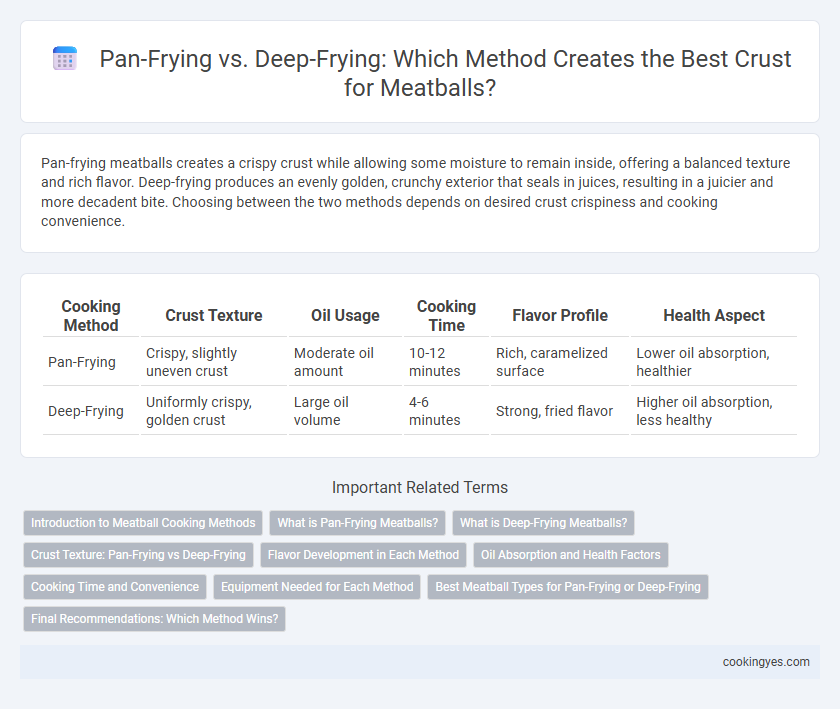Pan-frying meatballs creates a crispy crust while allowing some moisture to remain inside, offering a balanced texture and rich flavor. Deep-frying produces an evenly golden, crunchy exterior that seals in juices, resulting in a juicier and more decadent bite. Choosing between the two methods depends on desired crust crispiness and cooking convenience.
Table of Comparison
| Cooking Method | Crust Texture | Oil Usage | Cooking Time | Flavor Profile | Health Aspect |
|---|---|---|---|---|---|
| Pan-Frying | Crispy, slightly uneven crust | Moderate oil amount | 10-12 minutes | Rich, caramelized surface | Lower oil absorption, healthier |
| Deep-Frying | Uniformly crispy, golden crust | Large oil volume | 4-6 minutes | Strong, fried flavor | Higher oil absorption, less healthy |
Introduction to Meatball Cooking Methods
Pan-frying meatballs creates a crispy, golden crust by cooking them in a shallow layer of oil, offering greater control over texture and browning. Deep-frying submerges meatballs completely, producing an evenly crispy exterior with faster cooking times and a rich, crunchy crust. Each method affects the meatball's moisture retention and flavor profile, making the choice essential for achieving the desired culinary result.
What is Pan-Frying Meatballs?
Pan-frying meatballs involves cooking them in a shallow layer of oil over medium to high heat, allowing the crust to develop a golden-brown, crispy exterior while maintaining a juicy interior. This method promotes even browning and caramelization due to direct contact with the hot pan surface, making it ideal for achieving a flavorful crust without submerging the meatballs in excess oil. Pan-frying is preferred for smaller batches or when aiming for controlled texture and reduced oil absorption compared to deep-frying.
What is Deep-Frying Meatballs?
Deep-frying meatballs involves submerging them fully in hot oil, creating a crispy, evenly browned crust that seals in juices for maximum flavor. This method achieves a crunchy texture by rapidly cooking the exterior while keeping the inside tender and moist. Deep-frying requires precise temperature control, typically around 350degF (175degC), to prevent greasiness and ensure a golden, appetizing finish.
Crust Texture: Pan-Frying vs Deep-Frying
Pan-frying meatballs produces a crust that is crisp yet slightly uneven, offering a balance between tender interior and a golden-brown exterior with moderate oil absorption. Deep-frying creates a uniformly crunchy and thicker crust due to complete immersion in hot oil, resulting in a more pronounced crispness and faster cooking time. The choice between pan-frying and deep-frying impacts crust texture significantly, with pan-frying providing a delicate crust and deep-frying delivering a robust, crunchy exterior.
Flavor Development in Each Method
Pan-frying meatballs develops a rich, caramelized crust through the Maillard reaction, enhancing savory complexity and a slightly crispy texture. Deep-frying results in a uniformly golden, crunchy exterior that seals in juices while providing a satisfying crunch. Both methods elevate meatball flavor but differ in texture intensity and moisture retention.
Oil Absorption and Health Factors
Pan-frying meatballs creates a crisp crust with significantly less oil absorption compared to deep-frying, resulting in a lower calorie count and healthier fat content. Deep-frying submerges meatballs completely in hot oil, causing higher oil retention and increased fat intake, which can impact heart health negatively. Opting for pan-frying helps maintain a satisfying texture while reducing unhealthy trans fats and overall oil consumption.
Cooking Time and Convenience
Pan-frying meatballs creates a crispy crust with shorter cooking times, typically around 10-12 minutes, and offers greater control over browning and doneness using minimal oil. Deep-frying requires more oil and longer cooking times, approximately 12-15 minutes, but produces an evenly golden crust with a juicy interior, ideal for batch cooking. Convenience favors pan-frying due to quicker cleanup and less oil usage, while deep-frying suits larger quantities despite increased preparation and disposal efforts.
Equipment Needed for Each Method
Pan-frying meatballs requires a heavy skillet or non-stick frying pan and a moderate amount of oil to achieve a crispy crust while maintaining juiciness. Deep-frying demands a deep fryer or a large pot filled with oil heated to around 350degF (175degC) to ensure even cooking and a uniformly crunchy exterior. Choosing between these methods hinges on available kitchen equipment and desired texture, with deep-frying offering a crispier crust and pan-frying providing more control over browning.
Best Meatball Types for Pan-Frying or Deep-Frying
Pan-frying works best for meatballs made with lean meats like turkey or chicken, as it allows for even cooking and a crispy crust without excessive oil absorption. Deep-frying is ideal for beef or pork meatballs, which benefit from the fast, high-heat cooking that creates a uniformly golden and crunchy exterior while sealing in juices. Meatballs with added binders like breadcrumbs and eggs hold together better in deep-frying, ensuring a consistent crust and tender interior.
Final Recommendations: Which Method Wins?
Pan-frying meatballs creates a crispy crust with less oil absorption, preserving the meat's natural flavors and juiciness, making it ideal for a balanced texture and healthier option. Deep-frying delivers an evenly golden, ultra-crispy crust but increases fat content and may overpower delicate seasonings. For the best combination of flavor, texture, and nutrition, pan-frying meatballs is the recommended cooking method.
Pan-Frying vs Deep-Frying for Meatball Crust Infographic

 cookingyes.com
cookingyes.com